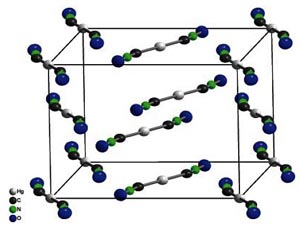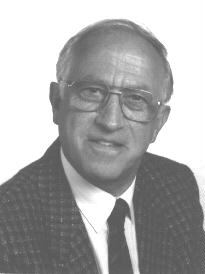Three centuries after its discovery by alchemists, the crystal structure of mercury fulminate – an explosive detonation compound known as Knallquecksilber, literally bang quicksilver, in German – has finally been determined.
Wolfgang Beck, Thomas Klapötke and their colleagues, Jürgen Evers, Michael Göbel, Gilbert Oehlinger, at the Ludwig Maximilians University in Munich, Germany, used X-ray crystallography to obtain a precise three-dimensional map of each and every atom in a single crystal of mercury fulminate. The crystal is orthorhombic in shape and is composed of separate Hg(CNO)2 molecules as expected with each mercury atom flanked by two carbon atoms. Beck explains that the structure confirms the molecule to be arranged as follows in an almost linear form: O?N?C?Hg?C?N?O (a single line represents a single covalent bond, while a triple line is a triple bond).

Crystal structure of mercury fulminate (Credit: Wiley/Beck)
In addition, says Beck, we can unambiguously show that the molecules in the crystal have a stretched-out, nearly linear form. They are not bent, and each mercury atom is not bound to two oxygen atoms, as they are amazingly still occasionally depicted in the literature.
Mercury fulminate is very sensitive to shock, friction, and sparks. It explosively decomposes to form mercury, carbon monoxide, and nitrogen. Seventeenth century alchemists were first to describe this explosive substance, among them Cornelius Drebbel and Johann Kunckel von Löwenstern. They made it from mixtures of spiritus vini (ethanol) and mercury in aqua fortis (nitric acid).

Wolfgang Beck
In his book Laboratorium Chymicum, von Löwenstern described the chemistry of the compound as being formed from the vigorous reaction of mercury nitrate with alcohol. By 1799, the English chemist Edward Howard isolated the compound and caused a sensation in the new scientific field of chemistry. However, it was not until FD Miles in 1931 that the first tentative investigations of the crystal structure of mercury fulminate by X-ray diffraction were undertaken. Beck and colleagues’ version is the first definitive structure determination however.

Thomas Klapotke
Not only has mercury fulminate had a chequered structural past but it has a truly explosive history. Alfred Nobel added mercury fulminate to his blasting caps for dynamite detonation to make safe dynamite and during the early part of the 20th century production in Germany alone was around 100 tonnes annually.
Further reading
ZAAC – J Inorg Gen Chem, 2007, 633, 1417-1422
http://dx.doi.org/10.1002/zaac.200700176
Dr. Wolfgang Beck homepage
http://www.chemie.uni-muenchen.de/ac/beck/
Dr. Thomas M. Klapötke
http://www.chemie.uni-muenchen.de/ac/klapoetke/
Suggested searches
mercury
alchemy